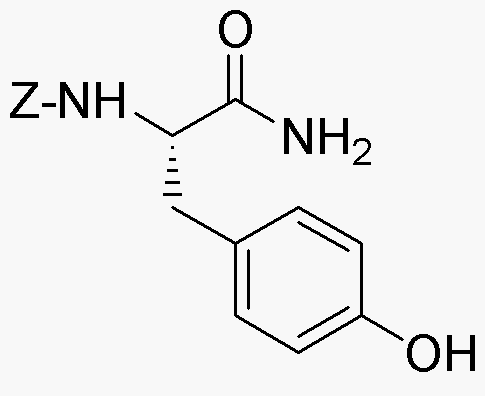Z-L-tyrosine amide is widely utilized in research focused on:
- Pharmaceutical Development: This compound serves as a key intermediate in the synthesis of various pharmaceuticals, particularly those targeting neurological disorders, enhancing the development of effective treatments.
- Protein Engineering: It is used in the modification of proteins, helping researchers create more stable and functional protein variants, which is crucial for biotechnological applications.
- Biochemical Research: Z-L-tyrosine amide is employed in studies related to enzyme activity and metabolic pathways, providing insights into cellular functions and disease mechanisms.
- Cosmetic Formulations: The compound is incorporated into skincare products for its antioxidant properties, helping to protect skin from oxidative stress and improve overall skin health.
- Food Industry: It can be used as a flavor enhancer or nutritional supplement, contributing to the development of healthier food products that cater to consumer demands for functional ingredients.
General Information
Properties
Safety and Regulations
Applications
Z-L-tyrosine amide is widely utilized in research focused on:
- Pharmaceutical Development: This compound serves as a key intermediate in the synthesis of various pharmaceuticals, particularly those targeting neurological disorders, enhancing the development of effective treatments.
- Protein Engineering: It is used in the modification of proteins, helping researchers create more stable and functional protein variants, which is crucial for biotechnological applications.
- Biochemical Research: Z-L-tyrosine amide is employed in studies related to enzyme activity and metabolic pathways, providing insights into cellular functions and disease mechanisms.
- Cosmetic Formulations: The compound is incorporated into skincare products for its antioxidant properties, helping to protect skin from oxidative stress and improve overall skin health.
- Food Industry: It can be used as a flavor enhancer or nutritional supplement, contributing to the development of healthier food products that cater to consumer demands for functional ingredients.
Documents
Safety Data Sheets (SDS)
The SDS provides comprehensive safety information on handling, storage, and disposal of the product.
Product Specification (PS)
The PS provides a comprehensive breakdown of the product’s properties, including chemical composition, physical state, purity, and storage requirements. It also details acceptable quality ranges and the product's intended applications.
Certificates of Analysis (COA)
Search for Certificates of Analysis (COA) by entering the products Lot Number. Lot and Batch Numbers can be found on a product’s label following the words ‘Lot’ or ‘Batch’.
*Catalog Number
*Lot Number
Certificates Of Origin (COO)
This COO confirms the country where the product was manufactured, and also details the materials and components used in it and whether it is derived from natural, synthetic, or other specific sources. This certificate may be required for customs, trade, and regulatory compliance.
*Catalog Number
*Lot Number
Safety Data Sheets (SDS)
The SDS provides comprehensive safety information on handling, storage, and disposal of the product.
DownloadProduct Specification (PS)
The PS provides a comprehensive breakdown of the product’s properties, including chemical composition, physical state, purity, and storage requirements. It also details acceptable quality ranges and the product's intended applications.
DownloadCertificates of Analysis (COA)
Search for Certificates of Analysis (COA) by entering the products Lot Number. Lot and Batch Numbers can be found on a product’s label following the words ‘Lot’ or ‘Batch’.
*Catalog Number
*Lot Number
Certificates Of Origin (COO)
This COO confirms the country where the product was manufactured, and also details the materials and components used in it and whether it is derived from natural, synthetic, or other specific sources. This certificate may be required for customs, trade, and regulatory compliance.


